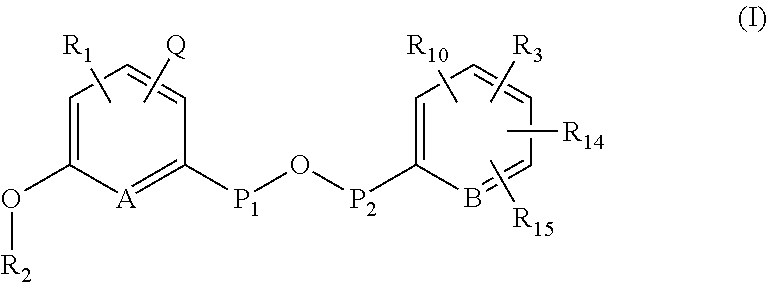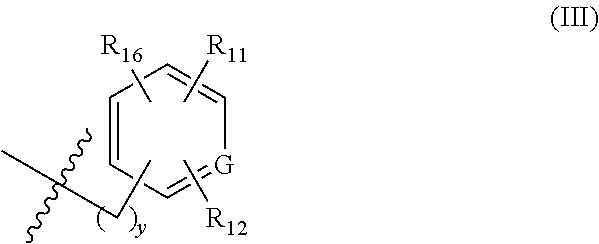Protease inhibitors
- Summary
- Abstract
- Description
- Claims
- Application Information
AI Technical Summary
Benefits of technology
Problems solved by technology
Method used
Image
Examples
example 1
2,6-Bis-(4-carbamimidoyl-phenoxy)-3-(4-fluorobenzene-sulphonamido)-pyridine
a) 2,6-Bis-(4-cyano phenoxy)-3-nitro pyridine
[0112]Potassium carbonate (2.09 g, 15.1 mmol) was added to a stirred solution of 2,6-Dichloro-3-nitro pyridine (1.0 g, 5.3 mmol), dissolved in 10 ml of DMF, at a temperature of 5° C. The flask was stirred for 10 min at the same temperature. 4-Cyano phenol (1.26 g, 10.6 mmol), dissolved in 5 ml of DMF was added dropwise to the reaction mixture over a period of 10 min and the flask was heated to 80° C. for 10-12 h. The reaction mixture was poured into ice-cold water and the product was extracted with 250 ml of ethyl acetate. Ethyl acetate layer was washed with water and brine solution. The organic layer was dried over anhydrous sodium sulphate and concentrated under reduced pressure to afford 1.35 g of the required 2,6-Bis-(4-cyano phenoxy)-3-nitro pyridine which was used in the next step without further purification. 1H NMR (DMSO-d6): δ 7.06 (1H, d), 7.32 (4H, dd), ...
example 2
2,6-Bis-(4-carbamimidoyl phenoxy)-3-(2-naphthyl sulphonamido)-pyridine
[0117]Intermediates (a) and (b) are the same as in Example 1.
c) 2,6-Bis-(4-cyano-phenoxy)-3-(2-naphthyl-sulphonamido)-pyridine
[0118]2-Naphthyl sulfonyl chloride (0.17 g, 0.76 mmol) was added to a stirred solution of 3-amino-2,6-bis(4-cyano phenoxy)pyridine (0.25 g, 0.76 mmol) along with other reagents as mentioned in Example 1(c) to afford 0.27 g of the required product. 1H NMR (DMSO-d6): δ 5.38 (1H, brs), 6.82 (1H, d), 7.12 (1H, d), 7.22 (2H, d), 7.35 (2H, dd), 7.44 (1H, d), 7.80 (7H, m), 7.95 (2H, m), 8.15 (2H, d), 8.56 (1H, s).
d) 2,6-Bis-(4-(N-hydroxycarbamimidoyl)-phenoxy)-3-(2-naphthyl-sulphonamido)-pyridine
[0119]N,N-Diisopropylethylamine (DIPEA) 0.36 ml (2.08 mmol) followed by 144 mg (2.08 mmol) of hydroxylamine hydrochloride was added to a stirred solution of 2,6-bis-(4-cyano-phenoxy)-3-(2-naphthyl-sulphonamido)-pyridine 0.27 g (0.52 mmol) in 10 ml of ethanol and the flask was heated at 100° C. for 8 h. The...
example 3
2,6-Bis-(4-carbamimidoyl-phenoxy)-3-(8-quinoline-sulphonamido)-pyridine
[0122]Intermediates (a) and (b) are the same as in Example 1.
c) 2,6-Bis-(4-cyano phenoxy)-3-(8-quinoline-sulphonamido)-pyridine
[0123]8-Quinoline sulfonyl chloride (0.172 g, 0.76 mmol) was added to a stirred solution of 3-amino-2,6-bis(4-cyano phenoxy)pyridine (0.25 g, 0.76 mmol). Using other reagents and reaction conditions as mentioned in Example 1(c) afforded 0.4 g of the required product. 1H NMR (DMSO-d6): δ 6.92 (1H, d), 7.11 (1H, d), 7.18 (2H, d), 7.25 (1H, d), 7.51 (2H, d), 7.56 (1H, dd), 7.66 (1H, t), 7.74 (2H, d), 7.80 (2H, m), 7.98 (1H, d), 8.20 (2H, m), 8.38 (1H, d).
d) 2,6-Bis-(4-(N-hydroxycarbamimidoyl)-phenoxy)-3-(8-quinoline-sulphonamido)-pyridine
[0124]2,6-Bis-(4-cyano phenoxy)-3-(8-quinoline-sulphonamido)-pyridine 0.4 g (0.77 mmol), DIPEA 0.53 ml (3.08 mmol) and 214 mg (3.08 mmol) of hydroxylamine hydrochloride were used to synthesize 2,6-bis-(4-(N-hydroxycarbamimidoyl)-phenoxy)-3-(8-quinoline-sulph...
PUM
| Property | Measurement | Unit |
|---|---|---|
| Inhibition | aaaaa | aaaaa |
| Inhibition | aaaaa | aaaaa |
| Inhibition | aaaaa | aaaaa |
Abstract
Description
Claims
Application Information
 Login to View More
Login to View More - R&D
- Intellectual Property
- Life Sciences
- Materials
- Tech Scout
- Unparalleled Data Quality
- Higher Quality Content
- 60% Fewer Hallucinations
Browse by: Latest US Patents, China's latest patents, Technical Efficacy Thesaurus, Application Domain, Technology Topic, Popular Technical Reports.
© 2025 PatSnap. All rights reserved.Legal|Privacy policy|Modern Slavery Act Transparency Statement|Sitemap|About US| Contact US: help@patsnap.com



